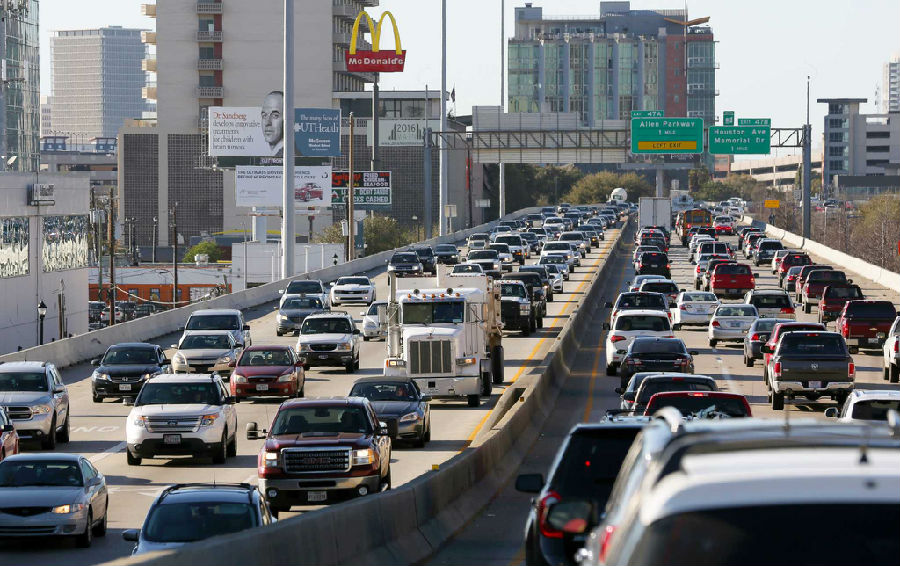The Katy Freeway in Texas connects Houston's western suburbs with the city's downtown.
得克萨斯州的凯蒂高速公路连接休斯敦的西部郊区和市区。
At its widest point, right here, it spans 26 lanes including parallel roads, before it intersects with another freeway, creating this massive web of pavement.
在最宽的地方,就是这里,它拥有26条车道,包括平行的道路,然后与另一条高速公路相交,形成了巨大的路面网。
The Katy Freeway is among the widest in the world.
凯蒂高速公路是世界上最宽的高速公路之一。
But it didn't start out this big.
但它一开始并没那么大。
The freeway was initially built in the 1960's with 6 lanes in most places.
这条高速公路最初建于20世纪60年代,公路的大部分区域都有6条车道。
But as the suburbs and office space around Houston started growing in the 1980's and 90's and more people began using the freeway - it became a traffic nightmare.
但随着休斯敦周围的郊区和办公场所在20世纪80年代和90年代开始扩建,越来越多的人开始走高速公路——这变成了一场交通噩梦。
By 2004, it was ranked the second worst bottleneck in the country.
2004年,它被列为美国第二大瓶颈路段。
To accommodate the growing commuter class, the city began a nearly 3 billion dollar expansion project, to add the additional lanes.
为了满足日益增长的通勤人员需求,该市展开了一项耗资近30亿美元的扩建项目,以增加车道。
The solution seems natural - more lanes equals less congestion.
解决办法似乎很自然——车道越多,拥堵就越少。
But traffic didn't get any better.
但交通状况并没有好转。
In fact, it got worse, in both the morning and afternoon commutes.
事实上,无论是早上还是下午的通勤,情况都变得更糟了。
The reason why hinges on a simple economic theory.
原因取决于一个简单的经济理论。
One that is often overlooked, because actually reducing traffic is far from simple.
这是一个经常被忽视的问题,因为实际上减少交通拥堵远非那么简单。
Highway expansion has gone hand in hand with the suburbanization of American cities like Houston.
公路的扩张与休斯敦等美国城市的郊区化齐头并进。
It becomes a self-fulfilling recipe for urban sprawl: a highway gets built to connect suburbs to a city center, which encourages more development along it, which necessitates even more highways when those get congested - and on and on and on.
它成为了城市扩张的自我实现方法:修建一条公路,将郊区与市中心连接起来,这鼓励了沿途的更多发展,当那些地方变得拥挤时,这就需要更多的公路——一条接一条。

The instinct to widen highways to relieve traffic makes sense - but there's a reason it doesn't work: due to a concept called "induced demand."
拓宽公路以缓解交通压力这一解决问题的本能是有道理的,但这是它不奏效的原因:一个叫做“诱导需求”的概念。
These represent 3 highway lanes.
它们代表3条公路车道。
And these balls are the commuters that drive on them.
这些球表示开车上下班的人。
These particular commuters - the red ones - will sit in traffic no matter how bad it gets, because they have to.
这些特定的通勤者——红色的球——无论交通多么糟糕,都会开车,因为他们必须这样做。
Driving to work on the highway is their only option.
在公路上开车上班是他们唯一的选择。
Let's say this is what congestion looks like, during peak rush hours.
假设这就是高峰时段拥堵的样子。
Once a certain number of cars get on the highway, traffic slows to a crawl.
一旦有一定数量的汽车上了公路,交通就会变得缓慢。
Now let's add a new lane.
现在让我们添加一条新的车道。
These drivers now have more room to spread out - which should make traffic flow better.
这些司机现在有了更大的空间来分散开来——这应该会使交通流更通畅。
That might happen at first, but it doesn't stay that way.
一开始可能会这样,但不会一直这样。
That's because there's another set of people who will take the highway under the right conditions - even though they have other commuting options.
这是因为还有另外一群人会在合适的条件下走公路——尽管他们有其他的通勤选择。
When a highway is congested, they might take local roads instead.
当公路拥堵时,他们可能会改走地方公路。
Or be able to drive during off-peak hours.
或者可以在非高峰时间开车。
They might use other modes of transportation, like public transit or biking.
他们可能会采用其他交通方式,如公共交通或骑自行车。
Or maybe they can work from home that day and skip the commute altogether.
或者他们那天可以在家工作,完全不用上下班。
In a few years, these people will start taking the highway, enticed by less congestion.
再过几年,这些人就会开始走公路,因为交通拥堵减少了。
This is induced demand at play: the more supply there is, the more demand will follow, to exhaustion.
这就是诱致需求在起作用:供给越多,需求就越大,直至枯竭。
And in this case, the supply is highway lanes.
在这种情况下,供应就是公路车道。
And sometimes, like on the Katy freeway, congestion gets even worse after a highway expansion, until some of those people with more options go back to their old ways.
有时,就像在凯蒂高速公路上,公路扩建后,交通拥堵会变得更严重,直到那些有更多选择的人回到原来的生活方式。
But in the end, you're still left with more drivers, and congestion that's at least as bad as it was before.
但最终还是会有更多的司机,交通拥堵至少会和以前一样严重。











